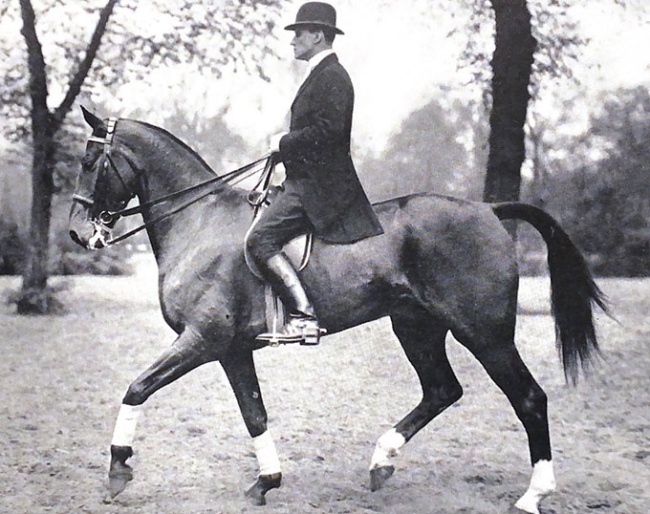
-- Text by Silke Rottermann for Eurodressage
Even though the readership of Eurodressage is large and focused on dressage, possibly only some still know the name of Richard Wätjen (1891-1966), let alone his life and work. This German rider and international dressage trainer was one of the most successful of his time and is today labeled as one of „the old masters“.
A Different Approach to Equitation
Richard Wätjen was born in a time very different from ours in many aspects. Regarding equitation the end of the 19th century and the beginning of the 20th did not yet see equestrianism as a principle sport. Those who aimed to ride dressage did it for the artistic aspect. Dressage was considered an art, even though the definition of what this art should look like differed quite a bit, according to the each country in which dressage was practiced.
Olympic glory was still some years away, let alone big, and the sport was not yet associated with some of despicable money making business one sometimes sees in the equestrian discipline nowadays.
In Europe and the USA the cavalry institutions were the place where a more or less uniform riding style based on the national cavalry manuals was taught.
A Start in Racing
Born in 1891 in Bremen into a family of businessmen, Richard Lacey Wätjen did not continue that tradition. Infected by the "equine virus," he got his first horse as a teenager and after completing school he spent time as a working student at the legendary Main Stud of Trakehnen, before switching to the thoroughbred breed in the no less renowned stud of Graditz for another year.
When the racing stables were transferred from Graditz to Hoppegarten in Berlin, Wätjen went with them. There he was seen training at the renowned Luisen-Tattersall in Berlin which was then run by Oskar Maria Stensbeck (1858-1939), a master of his time and until our days known as the trainer of the Trakehner chestnut gelding Gimpel (by Wandersmann xx), Olympic team champion 1928 and 1936.
Vienna
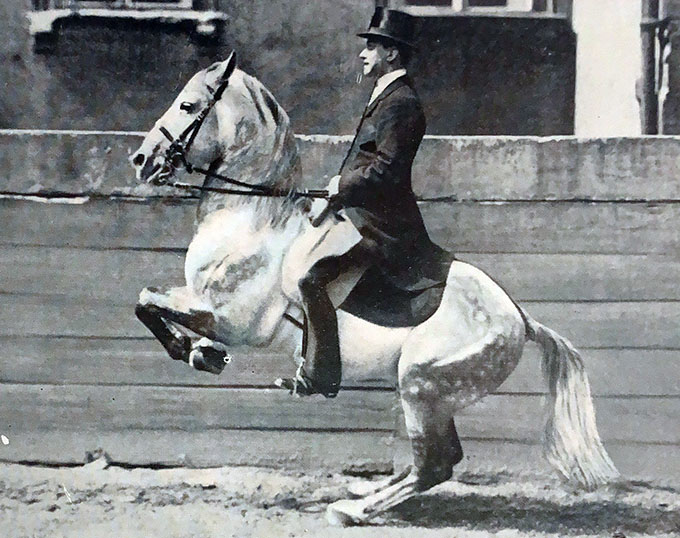
Spanish Riding School, around 1916
Not surprisingly, Richard Wätjen’s time at the SRS stamped his equestrian approach in a crucial way and his picture perfect seat and position was a testimony to the years he spent at the world’s greatest classical dressage institution at that time. The late Albert Stecken (1915-2011), German national dressage coach from 1971 to 1974, described Wätjen in Harry Boldt’s book „Das Dressurpferd“ as a typical representative of the school of Vienna, with his horses always being full of impulsion and perfectly straight.
A Changing Equestrian World
During Wätjen’s time in Vienna, which had irrevocably made him a deeply classical rider and trainer, some decisive turns had been taken in the equestrian world. Riding got included in the Olympic Games of the new age in 1912 and the FEI as a governing body was founded in 1921. Both events took care that more competitions were organized, nationally and slowly also internationally, even though the latter were still mainly a cavalry affair. A 1929 launched FEI rule-book defined the goal of dressage competitions as preserving „the Equestrian Art from the abuses to which it can be exposed and to preserve it in the purity of its principles, so that such principles of the discipline could be handed down intact to future generations of Athletes" (Article 419 nowadays). Richard Wätjen seemed to embody this governing article to the finest.
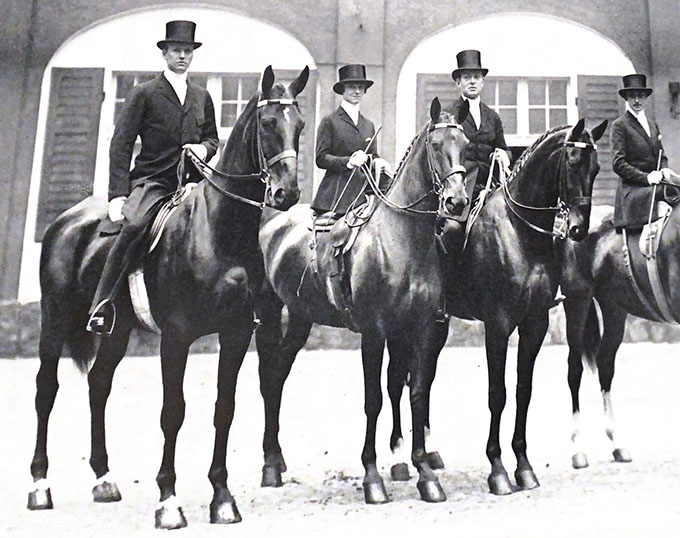
(Photo © Menzendorf)
Just three years after going independent he won at the CHIO in Aachen on the mare Haustochter.
Already in 1929 Wätjen, together with his successful contemporary riders and trainers Otto Lörke, Felix Bürkner and August Staeck, was awarded the very first German „golden rider badge“ for his merits in dressage classes at the highest level—he was the youngest of the quartet then.
The Secret to Germany's Success: a Military-Civilian Joint Venture
Germany’ supremacy in dressage began at the Olympics in Amsterdam in 1928 until the outbreak of the WW II. There is one exception in 1932 when the Great Depression did not allow riders to be sent to far away Los Angeles. This supremacy was not only based on its large scale of riding horse breeding, but even in the East Prussian area it was of course not comparable to today’s exceptional standards.
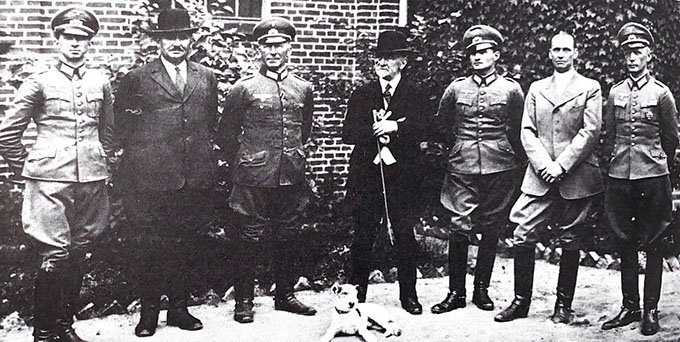
The trainers and officers who prepared riders for the 1936 Olympics in Berlin, with Wätjen second from right, Lörke second from left and Oskar Maria Stensbeck in the middle (Photo © Menzendorf)
The secret of success at the Olympic Games as well as at the few international competitions, which were annually held, was the unique cooperation between Germany’s cavalry school of Hanover and the private dressage trainers mentioned before. Almost all successful horses of that era were trained by civilians like Wätjen who as professionals were excluded from the Olympic Games where only military officers and (male) amateurs were allowed to start. So this military-civilian „joint venture“ allowed trainers to showcase their work at the Olympic stage, although they were not showing their horses themselves.
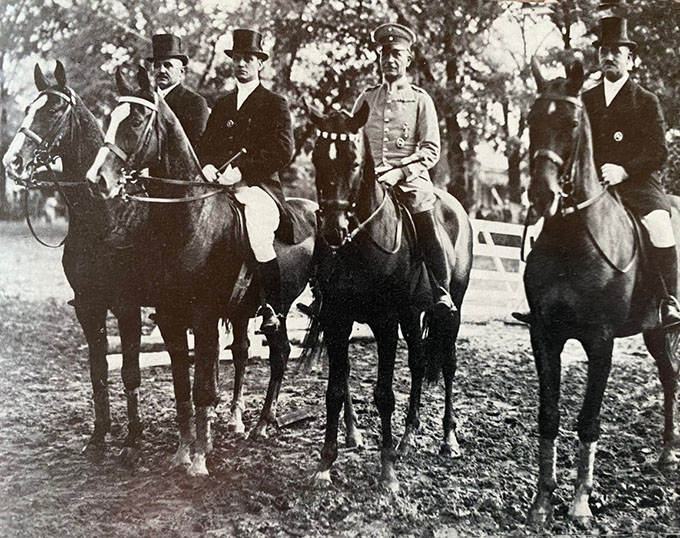
Otto Lörke, Richard Wätjen, Felix Bürkner and August Staeck
(Photo © Menzendorf)
For the 1936 Olympic Games in Berlin Wätjen’s top horse, the Trakehner gelding Burgsdorff (1935 CHIO Aachen winner), was presented by two different officers (Viebig, von Scheliha) in the lead-up, but finally was chosen as the reserve horse of Major Gerhard who won gold and silver in Berlin on the Otto Lörke trained Trakehner Absinth.
German Riding School
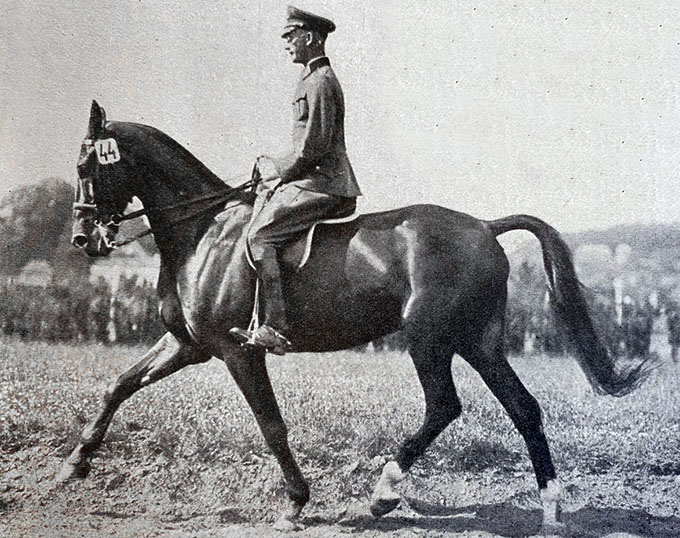
Richard Wätjen trained officers on his best horse
Burgsdorff, here ridden by Rittmeister von Scheliha in a trial
(Photo © St. Georg Archive)
So Wätjen trained at some of the most renowned institutions and stables of his time with some legendary dressage trainers and became one of the really big names himself between the two worlds wars, winning the even then highly prestigious Aachen Grand Prix twice.
Training American and British Eventing Riders
After World War II was over the equestrian scene in Germany was quite depressed in all aspects. Firstly it wasn’t easy for former top level dressage trainers to get sufficient work and income with what was left. Top horses had been destroyed, had disappeared, or had been confiscated by the winners of the war. The main stud Trakehnen was lost, the breeding in general suffered, and people had completely other worries than dressage competitions which were very rare at the new beginning.

(Photo © Menzendorf)
Based at the race-track, Colonel Thomson (1900-1971) from the US team contacted Count von Nagel — who was on the German jumping team which once toured the USA before the war— about a possible trainer. So in February 1948 Wätjen was employed to train the 13 eventing horses in dressage there. This approach came to fruition because in London the US eventing team won the gold medal (and an individual silver) and actually laid the foundation of their victory with good dressage scores. 1928 Olympic dressage team champion Hermann Linkenbach described the US team as „uniform in appearance and very well prepared," with horses who "showed precise programs, but were not mechanized."
Four years later it was the British eventing team which profited from Wätjen’s expertise. Although hard to imagine nowadays, the British were not that successful in eventing until the early 1950s.
The now iconic Badminton Horse Trials were inaugurated in 1949 and provided an invaluable contesting ground from then on. After a rather disastrous 1948 Olympics on home soil, Captain Tony Collings, himself winner at Badminton in 1950 and owner of the public Porlock Vale Riding School in Somerset, was chosen to prepare the British candidates for the Helsinki Olympics. Being well aware that he was not competent enough in dressage to improve his charges, Collings asked Wätjen to take over the dressage training.
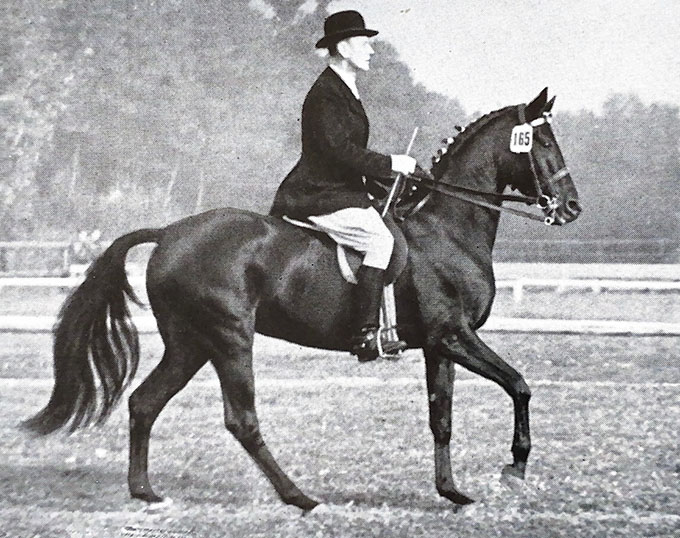
(Photo © Menzendorf)
Wätjen’s work paid dividends for the British team in the dressage part of the Olympics, as St. Georg magazine described it as „well seated riders, well trained horses on the account of good horsmanship." However the team was eliminated after Laurence Rook and Starlight missed a flag on cross-country.
Besides the interludes with foreign teams, Richard Wätjen worked in the Düsseldorf based dressage stable "Talihoh" in Germany and took care of the first training of a certain Hanoverian called Asbach who would later win Olympic bronze in Rome 1960 with Josef Neckermann (1912-1992).
Across the Pond
It didn’t take long for Wätjen to follow his compatriot Fritz Stecken (who had emigrated to the USA in 1947). He jumped the big pond in 1957.

horse Malteser at Sunnyfield farm
Although one has to mention that specialized dressage had anyway not played a significant role in the army. The exception was Captain Hiram Tuttle (1882-1956), a dressage Olympian who trained several Grand Prix horses in an autodidact way and who first trained Captain Robert Borg (1913-2005), the very last who was included in the US cavalry and who became a successful Olympic rider and trainer.
Wätjen had come over to teach a young Karen McIntosh (*1940) the secrets of advanced dressage. McIntosh was based at her family’s legendary Sunnyfield farm in Bedford not far from New York and had German bred horses to ride. The two best were Scipio xx (by Oleander xx), a chestnut thoroughbred who once was destined to become an eventer and with whom a juvenile Reiner Klimke (1936-1999) won the Prix St. Georges in Aachen 1956. Scipio xx, who was trained by Willi Schultheis (1922-1995), sold to the USA after the death of his owner, German hippologist and legend Dr. Gustav Rau (1880-1954). The second was the bigger framed Trakehner Malteser ,who was initially trained by Otto Lörke, was McIntosh’s second iron in the fire and is pictured in Wätjen’s book „Dressurreiten“ with the master himself. Karen McIntosh rode Scipio xx on the first ever female team of the USA at the 1959 Pan American Games to win a team silver medal, Malteser then carried her to the Olympic Games of 1964.
Teaching Dressage at Sunnyfield
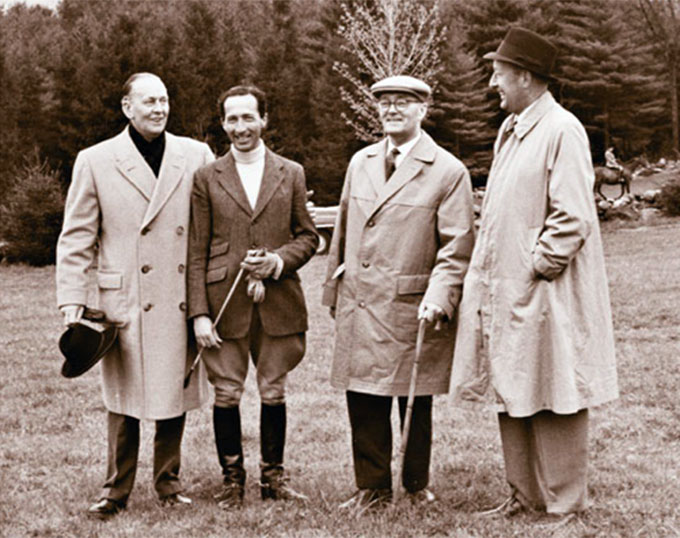
Whitney Stone (right) in the late 1950s during a trial
competition in the USA.
(Photo © USET Foundation)
Wätjen in turn convinced Sharp to focus on pure dressage which she successfully did, representing the USA at the Pan American Games 1967 in Winnipeg to win team silver and the Olympic Games a year later in Mexico-City.
Dressage, unlike the other two Olympic disciplines, was far from popular in the USA of the early 1960s and less than a handful of trainers were available for those with the means and the will to tackle this demanding branch of equitation.
Impact on US Equestrian Sport
Richard Wätjen, having been such a beacon of dressage in Germany between the wars, now became one of the first European trainers to make an impact on the other side of the Atlantic, not necessarily only on dressage, but to a certain extent also on some of their jumping and eventing riders who were world-class from the 1960s on.
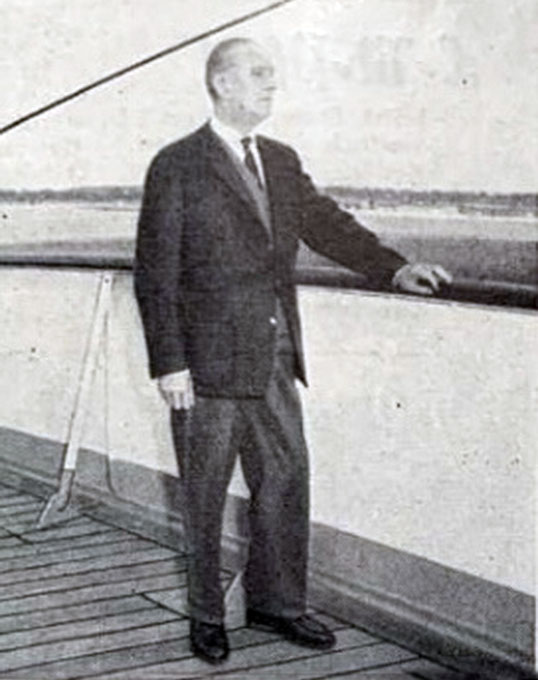
having shopped horses in Germany,
aprox. 1962
(Photo © St. Georg Archive)
When Dr. Reiner Klimke convinced the Americans during a visit to the USET headquarters to send a team to the 1964 Olympics in Japan, Wätjen got involved in the preparations. Even though the all-female team of Patricia de la Tour d’Auvergne (née Galvin, *1939), Karen McIntosh (*1940, married Collins) and Jessica Newberry (*1938, married Ranshousen) had to rely on their aging mounts of Rath Patrick xx, Malteser, and Forstrat, they came 4th in the team competition behind the dressage stalwart countries of that time: Germany, Switzerland and the Soviet Union.
Richard Wätjen taught almost right until his death. He left the USA at the end of 1965 to spent Christmas in Germany and died only a few weeks later on 13 January 1966, after having worked on the 6th issue of his book in the last weeks of his life. On 17 January 1966 he was laid to rest in Siegburg.
Legacy
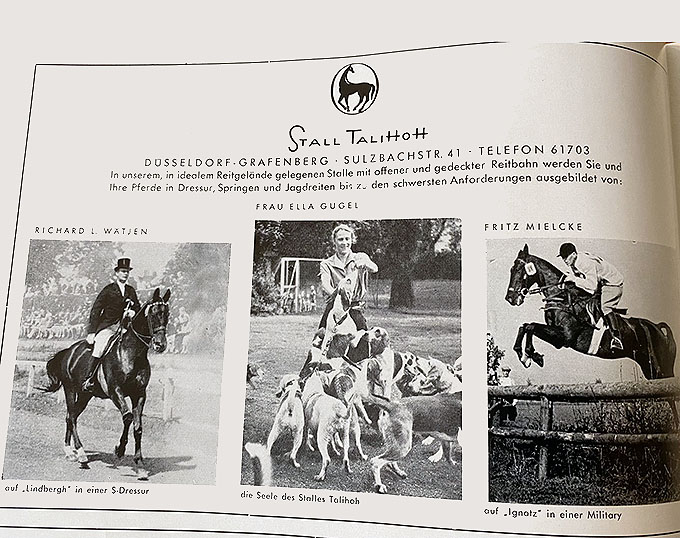
We should not forget and ideally revive the essence of his teachings. They seem quite deliberately forgotten, but are in fact more necessary than ever in view of the recent scandals involving clear horse abuse and in times in which big business dominates dressage sport. He taught and believed in a form of partnership with the horse that was once considered an art.
Josef Neckermann (1912-1992), the first dressage World champion in history (1966), described Wätjen in his 1992 autobiography as a patient, an extremely sensitive, and a thinking rider.
"Wätjen never rushed his horse’s training, but trained them slowly, step by step, to teach them new things. This is a patience which pays twice and three times dividends in a dressage horse’s later life and which we cannot demand often enough."

successful horse, the Trakhener gelding Burgsdorff,
in 1936
Read the excerpt „30 Years Practice“ in Part II coming tomorrow.
-- Text by Silke Rottermann for Eurodressage
References
- R.A. Abé, In Memoriam Richard L. Wätjen, in: L’Année Hippique 1967/1968, p. 53.
- Dietbert Arnold, Die Bilder der Deutschen Reitschule, Pferdesport Verlag Rolf Ehlers GmbH, Bremen 1998.
- Franz Rudolf Bissinger, Sankt Georg Almanach 1952, Verlag Sankt Georg, Neuss 1952.
- Harry Boldt, Das Dressurpferd, Edition Haberbeck, 6. Auflage, Lippe-Lage 1978.
- Jackie C. Burke, Equal to the Challenge, Pioneering Women of Horse Sport, Howell Book House, New York 1997.
- Carol Foster, Badminton Horse Trials - A history of the three-day-event, Barrie&Jenkins Ltd, London 1980.
- Hermann Linkenbach, Olympische Reiterwettkämpfe London 1948, Sankt Georg Kunstverlag, Düsseldorf 1948.
- George H. Morris, Unrelenting, Trafalgar Square Books, Vermont 2016.
- Josef Neckermann, Im starken Trab, FN Verlag, Warendorf 1992.
- Angela Rippon, Badminton, Salem Horse Publishers, Topsfield 1987.
- Waldemar Seunig, Meister der Reitkunst und ihre Wege, Erich Hoffmann Verlag, Heidenheim 1960.
- Debby Sly, Badminton Horse Trials-The triumph and tears, David and Charles 1999.
- Robert D. Thompson, U.S. Army Olympic Equestrian Competitions 1912-1948, Schiffer Publishing Ltd., Atglen P.A. 2008
- Herbert Wernstorff, Große Reiter, edle Pferde, Löwes Verlag Ferdinand Carl KG, Bayreuth 1972.
Internet sources
- https://issuu.com/wynnwood/docs/april_may2020/s/10593864
- https://www.chronofhorse.com/article/team-selection-and-training-has-always-sparked-discussion-and-controversy/
- https://nyshistoricnewspapers.org/?a=d&d=pt19610831-01.1.21&e=-------en-20--1--txt-txIN----------
- https://vault.si.com/vault/1959/08/10/three-girls-for-the-grand-prix
- https://inside.fei.org/system/files/FEI_Dressage_Rules_2021_Mark_Up_Version.pdf
- https://olympics.com/en/athletes/karen-stuart-mcintosh
Interviews
- Interviews with Donnan Sharp in January 2024.